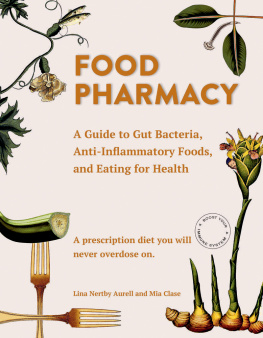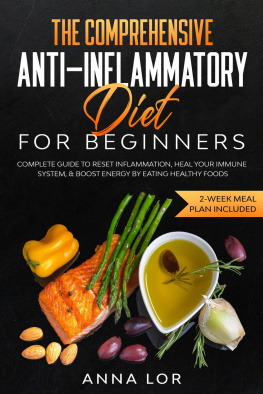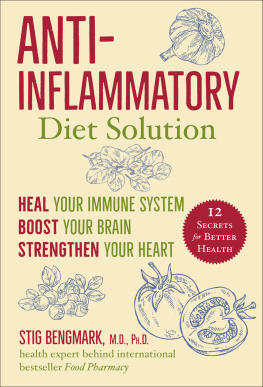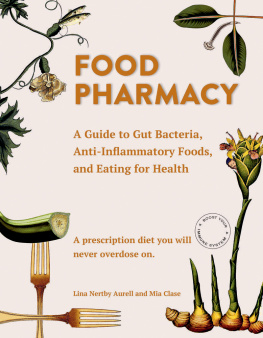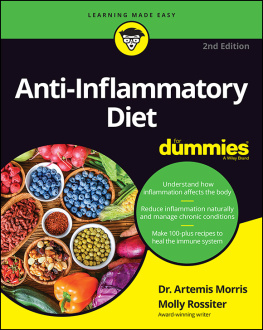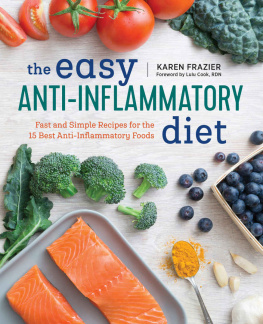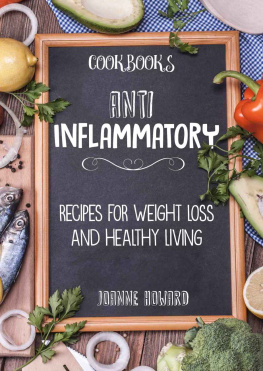
Picture a political scientist with a photographic memory and an absent-minded copywriter who, one day, both suddenly give notice at their respective workplaces and go on to launch a blog about food and health. Add to the mix an eighty-seven-year-old professor of medicine, four little hooligans who spit out everything put in front of them, and the half million readers who found their way to the blog in its first year. Voil! Meet the Food Pharmacy.


CONTENTS

WE ARE LINA AND MIA. A few years ago, we started to take an interest in the effect the food we eat has on how we feel, and its safe to say that at the time we felt somewhat bewildered. New research promoted 5:2 and LCHF diets everywhere and were touted by overconfident health experts, which made it just about impossible to sift through all the advice and findings. One day we got fed up and launched a blog to try to make some sense of all the conceptson our own.
Actually, things didnt begin quite like that. A few months earlier, we were in Helsingborg (a coastal city in the south of Sweden) to have lunch with Stig Bengmark, a professor of medicine. Three mouthfuls into a beet burger, Stig cracked open the door to what was for us a totally new world.
Bengmark was Professor of Surgery at the University of Lunds Medical Faculty, in southern Sweden, from 1970 to 1994; he was also Chairman and Director of the Department of Surgery at the Lund University Hospital from 1970 to 1992. Many years ago, he realized that about 80 percent of the bodys immune system is located in the gut (gastrointestinal tract), whereupon he decided to devote the remainder of his career to finding out how to optimize ones intestinal flora. Today, Stig is Honorary Visiting Professor at University College, London University, where his task is to conduct research and teach about the best conditions for health.
On second thought, things didnt quite happen like that, either. A few years earlier, we had both become parents for the first time; with the concurrent births of Ninni and Ludde, we realized that we were not immortal. The sudden feeling of responsibility for someone elses life, along with wanting to always be there for them, resulted in months of nightly sessions Googling diseases, symptoms, and information on how to stay healthy, active, and strong forever. Somewhere amid all this anxiety, an interest was sparked on how much we ourselves can influence things by what we eat.
This book is a compendium of what we have learned. After blogging day and night for two years, its time to summarize, in plain and simple language, all the research we have posted on the blogand to push it even further. Even though we have long known that we have billions of bacteria in our bodies, it has taken scientists only until quite recently to grasp how critical a rich and thriving intestinal flora is to our health. Today, gastrointestinal research is one of the hottest fields in science, and we are constantly acquiring new knowledge and a deeper understanding of the connection between bacteria, intestinal flora, and well-being.
Today, we are aware that intestinal flora exerts a very strong influence on how we feel. We know that the flora consists not only of good bacteria but also bad, potentially disease-causing bacteria. We are conscious that good and bad bacteria can be strengthened or weakened depending on what we eat. We know that an excess of bad bacteria contributes to chronic inflammation; and we also know that chronic inflammation can make us ill.

In this book, wed like to show you the fundamental connection between intestinal flora, inflammation, and your health. More important, we want to show how you can influence your intestinal flora and the way you feel in the long run through your own food choices.
This is the story of how we got interested in the link between health and food and how, to our surprise, we ended up among intestinal bacteria. Without Professor Stig, we would both still be at our old jobs (and still making a salary!). Wed also like to take the opportunity here to thank all the other science journalists, physicians, and scientists whom weve had the pleasure to get to know over the past few years. Thank you, everyonewithout you, this book would have ended up being a simple haiku.
So, lets start from the beginning.

THE INTESTINAL FLORAS COMMANDMENTS
Per the Food Pharmacy:
Focus on what you can eat, instead of what you must avoid eating.
Enjoy lots of different and colorful raw vegetables.
Eat meat sparingly.
Gorge on leafy greens.
Drink a green smoothie daily.
If you eat fish, opt for wild-caught varieties.
Eat slowly and chew thoroughly.
Skip processed foods.
Seek out organic food.
Increase foods nutritional values by sprouting and fermenting them.
Lower the temperature by a few notches.
Choose your fats wisely.
Yummy
Add some zing to your food with herbs and spices.
Teach yourself and your kids to get comfortable without sugar.
Become a nutrient hunter (and avoid fillers).
Give your body a chance to rest now and then with periodic fasting.
When you feel stressed out, take a deep breath and try to focus on the positives of life.
Move your body often!
Let food be your main source of nutrients, but feel free to give it a boost of added vitamin D, omega-3, and synbiotics.
Relax, and dont be too hard on yourself. That is the most important commandment of all.

PLATOS PLATE MODEL

LET US TELL YOU ABOUT Plato before we delve deeper into intestinal bacteria and inflammation. (Well, not exactly us; its Lina who will tell you about Plato. Mia is going to take this opportunity to paint her nails.)
Plato was born in Athens a few hundred years BC. He was a Greek philosopher, mathematician, and author, as well as the father of Platonism, which has contributed in many ways to Western philosophy. One example of Platos legacy is his idealism, which is part of the foundation of mathematical philosophy. Well, you can see for yourself that Plato wasnt a few sandwiches short of a picnic.
A big part of Platos philosophy is known as Platos theory of ideas or forms. His theory encompasses two worlds, namely 1) the ideal (the perfect idea), and 2) the physical realm. According to Plato, nothing can exist in life without there also being a corresponding perfect idea (eternal, unchanging) of the same kind, in the world of ideas and forms.
Next page
